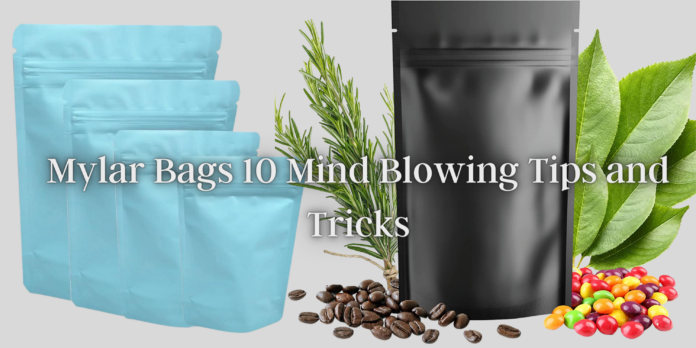Mylar bags are a great way to store food and other items. They are made of a durable material that is resistant to moisture and pests. Mylar bags can be used for long-term storage, and they are also freezer-safe. Find out how to make your mylar bags in this article.
Mylar bags are a great way to store food for long-term storage, but they can also be used for several other purposes. They are made of a durable material that is resistant to moisture and pests, making them ideal for protecting the contents when stored away from home. Mylar bags can withstand rough handling during transport, which makes them useful for storing valuables in the event of an emergency. The lightweight nature of mylar bags makes them easy to carry around and convenient to store in vehicles or at work.
Mylar bags come in different sizes and shapes: some have gusseted bottoms while others have flat bottoms; some are wide-mouthed while others have narrow mouths. The bags are most commonly transparent, but other colors and designs are also available.
Smell Proof Plastic Mylar Bags
The plastic mylar bags are the perfect option for you to keep your things safe, but without worrying about them smelling bad. The bags are meant to protect important items from bacteria and moisture. They are also durable enough to withstand rough handling during transport! The bag is lightweight, making it easy for you to carry around with you wherever you go. They are also transparent, which makes it easy for you to see what is inside!
Mylar bags can be manufactured from many different materials. They are often made of a metal-coated polymer, which is a type of plastic with aluminum foil bonded to both sides. Mylar bags protect their contents from exposure to light as well as moisture and air. In addition, the mylar material provides the ultimate barrier against gas, odors, liquids, and pests.
10 Mind Blowing Tips and Tricks
- Decide how many mylar bags you would like to make. For long-term storage, it is recommended that you store an entire year’s worth of food at a time. However, this will depend on the size of your family, so it may be necessary to prepare more than one bag depending on these factors.
- Determine how much space you have available in your home for storing the bags and other items that you plan to put inside them (e.g., tools, extra clothes). Remember that when filled with provisions, mylar bags can be extremely heavy and bulky; therefore, they should not take up too much space in your home.
- Buy the mylar bags you need. If buying pre-made bags, take note of how many are available in each pack to ensure that you buy the right number for your needs. Always purchase extra bags to account for spoilage and breakage during storage, transport, or handling. The sizes featured here are commonly used by long-term food storage providers:
4–Gallon size for dry goods such as grains, beans, legumes, flour, etc.
6–Gallon size Also great for rice & sugar/flour
10–Quart size Great for smaller items like beans & grain.
8×20–Pint-size Great for spices or herbs humidity-sensitive products.
5×9–Snack-size great for MRE’s energy bars & accessory items
- If you do not have any mylar bags on hand, check around the local area to see if any wholesalers or retailers can supply them. You may also consider asking your friends and relatives if they have any bags in storage that you could borrow for your project. Remember that these are common household items, so they are usually readily available at home improvement stores such as Home Depot or Lowes.
- Gather all the materials you will need to make the bags: a cutting tool, ruler, pencil/pencil sharpener, marker pen (or paint), measuring tape, iron with steam setting (ironing is optional), and fusing tool (heat sealer or paint-on adhesive).
- Measure the width of your ironing board. Mylar bags should not be larger than this, so adjust your design if necessary to fit inside the available dimensions. Draw a template on paper according to this size; an example is shown here:
- Use the template you drew in step 6 to cut out several pieces, for use as stencils while marking your mylar bag. Cut out one piece at a time while using them as templates for other parts until all of your stencils are made; place each stencil over its corresponding material while marking with the marker pen to avoid confusion when cutting out multiple sheets. You can make 10 bags from one A1-sized sheet of mylar material.
- Cut out all the stencils for your project, remembering to leave a 1/2 inch margin at the top and bottom of each template for overlapping purposes. Using two or more templates will allow you to make several bags in one sitting; this is recommended because it saves time and effort when cutting multiple sheets of bags at once. By doing so, you can also ensure that your bag dimensions are consistent with each other.
- Carefully cut around the marked parts using scissors or a sharp utility knife (e.g., an X-acto blade). After making all cuts, inspect them afterward to see if they line up correctly with each other along their perimeters when assembled. To do this, hold the stencils at their sides while making sure that they are even with each other on all sides. If some areas remain unsealed, use your fusing tool on them to complete the seal.
- 1 Carefully apply heat to all unsealed parts of your design using a hot iron or heat gun (e.g., a paint stripper). Be careful not to burn yourself when doing so–this is especially important when using an open flame such as a paint stripper near flammable materials like paper and plastic sheets.












